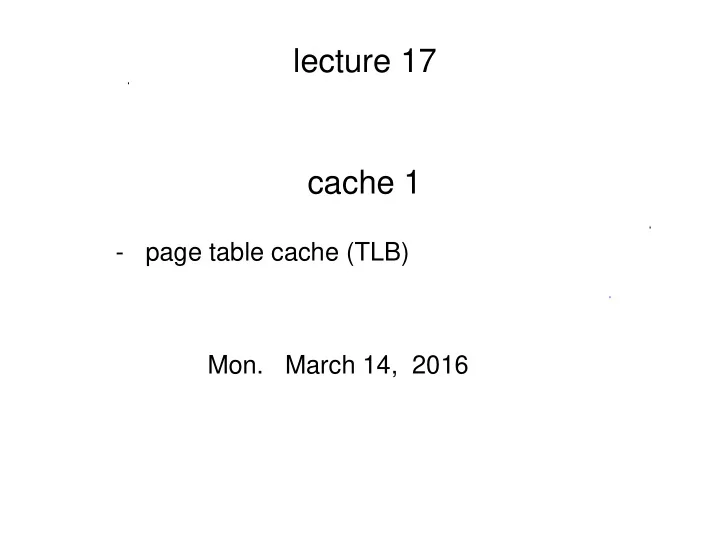

lecture 17 cache 1 - page table cache (TLB) Mon. March 14, 2016
some key ideas from last lecture page tables are used to translate a virtual (program) addess to a physical address. Page tables are in the kernel part of memory
31 ... 12 11 ... 0 page offset virtual page number (20 bits) table lookup copy page offset physical page number (18 bits) 29 ... 12 11 ... 0 physical address (RAM) e.g. 1 GB = 2^30 bytes
recall MIPS CPU pipeline Today we talk about Memory. Today we talk about Memory.
IF and MEM stages (conceptual only) It is too slow to go always to main memory (RAM) or to disk. Instead, we want to use a fast memory that can be accessed in one clock cycle (SRAM).
implementation with caches (SRAM) The page table cache is called the "translation lookaside buffer" (TLB). We can think of two TLB's, for data and instructions. We can assume physical page numbers in TLB are in main memory only (i.e. not on disk, otherwise page swap is needed). Instruction and data caches are separate.
Page table cache (called the "Translation Lookaside Buffer" or "TLB") e.g. Suppose the TLB has 2^9 = 512 entries. each entry Only a subset of entries from the is a page table fits into the TLB physical (2^9 out of 2^20 ) page number How to index and 'recognize' these entries ?
31 ... 12 11 ... 0 page offset virtual page number partition VPN into two parts 31 ... 21 20 12 11 ... 0 page offset "tag" TLB index 11 bits 9 bits 12 bits
31 ... 21 20 12 11 ... 0 page offset "tag" TLB index tag physical valid page number physical address
Example (3 virtual addresses) tag TLB index page offset (11) (9) (12) 01010100100 001001011 010101111111 01010100100 001001011 001001001001 01000111011 001001011 001001001001 All three map to the same TLB entry. The first and second are on the same page but correspond to different physical addresses (because the offsets differ) The second and third have the same page offsets, but are on different pages.
[ASIDE: Different processes can share the TLB, so one typically adds a process identification (PID) field and verify that the translation is indeed for that current process'es page table. ] page offset "tag" TLB index valid tag physical page number PID physical address
TLB Hit versus Miss Only a subset of entries from the page table fits into the TLB. "Hit" = the translation we want is in the TLB "Miss" = the translation we want is NOT in the TLB (and need to be brought into the TLB from the page table) What does the TLB circuit look like? How can we decide if we have a hit or a miss ? We will discuss TLB misses next lecture (analogous to page fault from last lecture).
Instruction and data caches virtual physical physical virtual address address address address We can assume entries in all these caches correspond to pages that are in main memory only (i.e. otherwise page swap would be needed... more to say about that in future lecture)..
Recommend
More recommend